Imagine if you can, a young girl’s journey. A ten-year-old girl, a student, went to one of our robotic competitions through our MS&T Education and WorkForce Programs and got interested in science. This interest excited her to enroll in one of our member Modeling and Simulation (M&S) Aviation Magnet middle school programs — one that uses aviation simulators purchased by Lockheed Martin Corporation. Afterward enrolling in one of our member Modeling and Simulation (M&S) Aviation Magnet programs that use Lockheed Martin Corporation purchased aviation simulators in middle school classrooms. Next, continuing her journey to a high school in which NCS assisted in developing an M&S curriculum with a certificate in Modeling and Simulation. This school now teaches over 300 M&S students annually. She then went to one of our two-year state college programs that focus on robotics and simulation. The college’s commitment to these STEM topics is because the MS&T community made it a priority and has impacted them by doing things like sitting on their academic boards. Now the girl, a young woman, graduates from University Central Florida (UCF), after working in the co-sponsored Robotics Club at Partnership II in Research Park while simultaneously working in the Partnership Lab, one where the military collaborates with UCF on joint research. This was the perfect opportunity for her as she developed her thesis on Warfighter science and technology priorities. And along the way, she earned one of the many M&S scholarships offered by the National Center for Simulation. Now she is a newly minted Ph.D. out of this pipeline, working at SAIC, or Boeing, or Lockheed Martin — or the Navy, Army, Air Force, or Marine Corps. Or, maybe even starting her own company through the UCF Incubator program. So, what is the ROI on this journey? Like you – we have no clue! But she knows. Because she now helps other girls by engaging with us on our STEM Education and Workforce Committee activities. Measuring ROI on this journey is difficult, but we are sure the families are very thankful that we have created this Modeling, Simulation, and Training journey and opportunity, because, it is true.
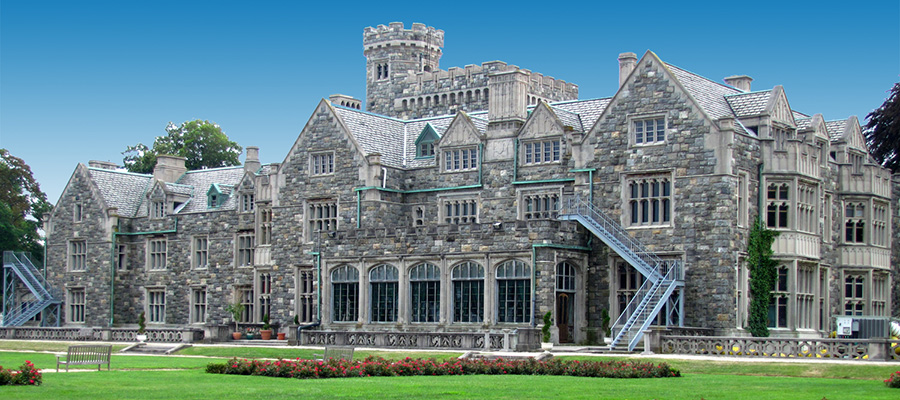
Legendary aviator Charles Lindbergh was a close friend to Harry Guggenheim who owned the Guggenheim Estates at Long Island Sound, New York. In 1942 his wife Florence Guggenheim donated 162 acres to the Institute of Aeronautical Sciences.
The Institute of Aeronautical Sciences leased, and then sold the property to the United States Navy in 1946. The Navy operated the Naval Training Device Center on the property and renovated Guggenheim’s Hempstead House and Castle Gould for their offices and laboratories. The Center designed and tested electronic systems for the military. In addition to the military staff, the Navy employed 800 civilians on this site at its peak of operations during the 1950s and 1960s. In 1967, the Naval Training Devices Center was moved to Florida, and the 162-acre site was declared government surplus.
While the Long Island Sound location was going through changes one thing was clear aviation training needed to improve with more and more of the military taking to the skies. Fortunately, someone was up to the challenge, a man named Edward Link was creating something quite special. The original Link Trainer was created in 1929 out of the need for a safe way to teach new pilots how to fly by instruments. In the early 1930s, pilots from the Army Air Corp were crashing at astonishing rates as they took to the air from a mandate from President Herbert Hoover to deliver the mail. Ed Link was using his knowledge of pumps, valves, and bellows gained at his father’s Link Piano and Organ Company to create a flight simulator that responded to the pilot’s controls and gave an accurate reading on the included instruments. After a demonstration of his simulator technology to Government officials in Washington, DC Link was awarded the first simulator contract of six (6) trainers as shown below each costing $3,700.
More than 500,000 US pilots trained on Link simulators, as were pilots of nations as diverse as Australia, Canada, Germany, New Zealand, United Kingdom, Israel, Japan, Pakistan, and the USSR. Following WWII, Air Marshall Robert Leckie (wartime RAF Chief of Staff) said “The Luftwaffe met its Waterloo on all the training fields of the free world where there was a battery of Link Trainers.”
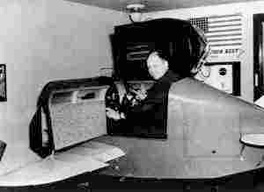
As pilots improved their proficiency with simulators another pioneer was about to take things to the next level. Rear Admiral DeFlorez was a naval aviator in the United States Navy and was actively involved in experimental aerospace development projects for the United States Government. As both an active duty and a retired U.S. Navy Admiral, DeFlorez was influential in the development of early flight simulators and was a pioneer in the use of “virtual reality” to simulate flight and combat situations in World War II.
The military’s central hub for modeling, simulation and training in Central Florida Research Park is a tribute to Admiral Luis DeFlorez.
In April 1941 Commander DeFlorez became head of the new Special Devices Desk in the Engineering Division of the Navy’s Bureau of Aeronautics (BuAer). De Florez championed the use of “synthetic training devices” and urged the Navy to undertake the development of such devices to increase readiness. In June, the desk became the Special Devices Section.
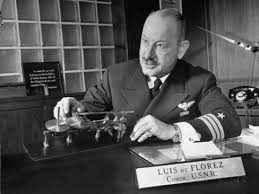
Throughout World War II, the Section developed numerous innovative training devices including ones that used motion pictures to train aircraft gunners, a device to train precision bombing, and a kit with which to build model terrains to facilitate operational planning in the field. The Special Devices Section grew and became the Special Devices Division located at the Guggenheim Estates. In August 1946, the Division has commissioned the Special Devices Center.
As the Special Devices Division evolved and grew, it was aligned at various times under several different parent organizations within the Navy and eventually became the Naval Training Device Center (NAVTRADEVCEN). Over a three-year period in the mid-1960s, the Center moved from its Long Island location to Orlando, Florida, taking residence as a tenant activity at the then-Orlando Air Force Base, that installation subsequently becoming Naval Training Center Orlando in 1968 until its closure in 1999 pursuant to a 1993 Base Realignment and Closure Commission decision.
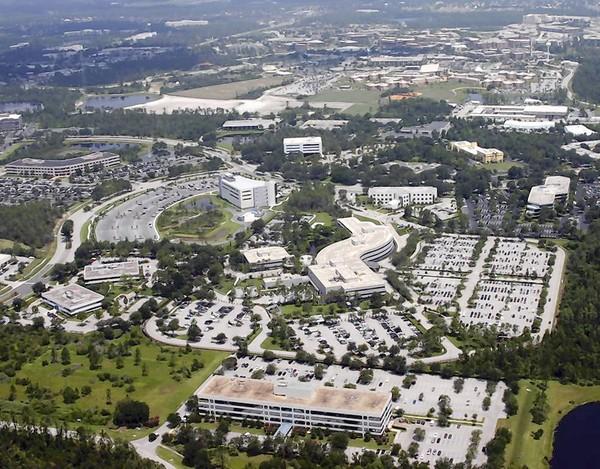
In 1988, the Center moved from NTC Orlando to its present headquarters approximately 15 miles east of its former location and just south of the University of Central Florida campus into Central Florida Research Park. The main building complex was then named for its founding father, Rear Admiral DeFLorez.
On October 1, 1993, the Naval Training Systems Center became today’s Naval Air Warfare Center – Training System Division (NAWC-TSD). In 2005, the physical facility and property were also designated as an independent base named Naval Support Activity Orlando, making it the sole remaining active-duty U.S. Navy installation in the Orlando area.
The Army and Navy partnership in developing training aids, devices, simulators, and simulations what is called in the industry (TADSS) is one of the longest-lasting agreements in DoD. The Army and Navy originally signed this agreement back in March of 1950 at the Guggenheim Estates. For 69 years this relationship has been going strong and now has prompted other military Services to join what is commonly called Team Orlando. This longest-standing interservice agreement within DoD was the catalyst to grow beyond just the Army and the Navy, beyond DoD, but now includes our industry and academic partners located here in the Central Florida’s modeling, simulation and training community anchored by the DeFlorez complex.
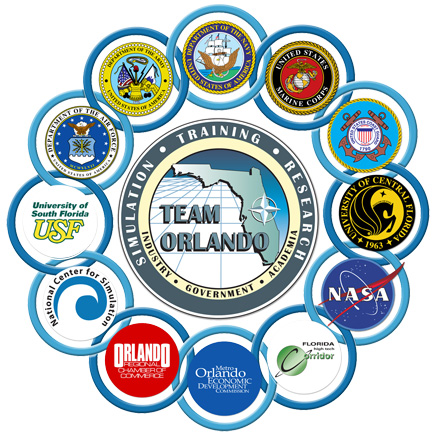
Team Orlando is a growing community of organizations across Defense, Government, Industry, and Academia working together to accomplish their respective missions with a common goal of improving human performance through modeling, simulation, and training while working on shared challenges. Team Orlando is accomplishing its vital national mission as a direct result of this unique collaboration between the nation’s leading military simulation research, development, and acquisition commands, along with the integral capabilities, talent, resources, and support of the local government, private industry, academia, and government organizations.
The National Center for Simulation (NCS) was formed in 1993 as the link among the defense industry, NASA, other government agencies, and academia on behalf of the entire MS&T community. Its mission is to promote, protect, and grow the MS&T community by facilitating networking among its growing local, national, and international membership and partners in government, industry, education, and commerce.
NCS is headquartered in Orlando, Florida – home of the epicenter of the modeling, simulation, and training industry. Located here are hundreds of MS&T companies, the University of Central Florida, the acquisition commands for the Army, Navy, and Marine Corps, the Air Force Agency for Modeling & Simulation, headquarters of the Army Futures Command Cross-Functional Team Synthetic Training Environment (CFT-STE), Army Contracting Command Orlando, Space Force plus 10 other federal government agencies and joint commands. Orlando’s Central Florida Research Park provides an environment that has fostered collaboration, cooperation, and partnership between academia, industry, and government for over 30 years.
Today, NCS works to strengthen the simulation community’s synergy, foster innovation, and tell the story of MS&T to decision-makers and the general public. NCS members actively have created an environment where together they are working on innovation of MS&T and shared challenges which result in new awareness and applications for military readiness, space exploration, health care, transportation, education, entertainment, and technology development.
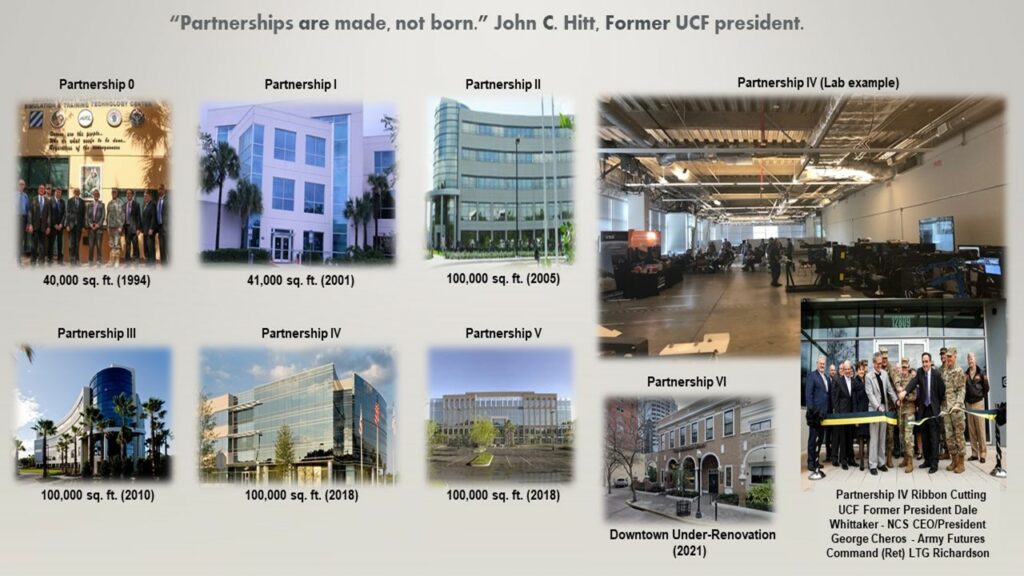
The State of Florida working in collaboration with the University of Central Florida, National Center for Simulation, and Orange County Research and Development Authority have acquired Partnership Buildings as a way to help the military solve its logistics challenges during the growth of the modeling, simulation, and training expansion. Most recently on April 30, 2018, the Partnership Buildings in Research Park were unified to honor retiring President John C. Hitt for his support of technological industries that have created an impact on local, state, and national levels. Known today as the John C. Hitt Partnership Complex.
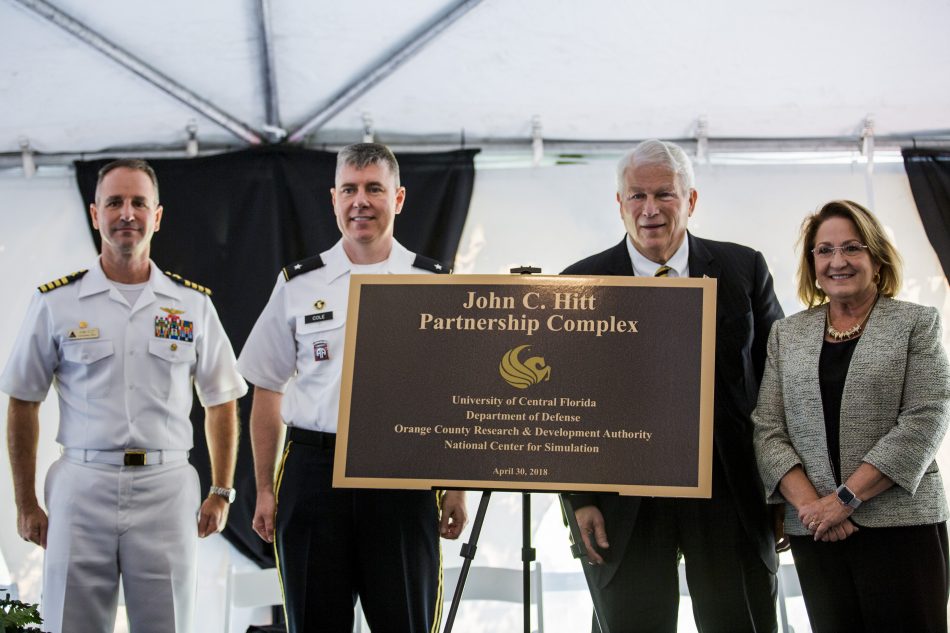
Key Event Timeline